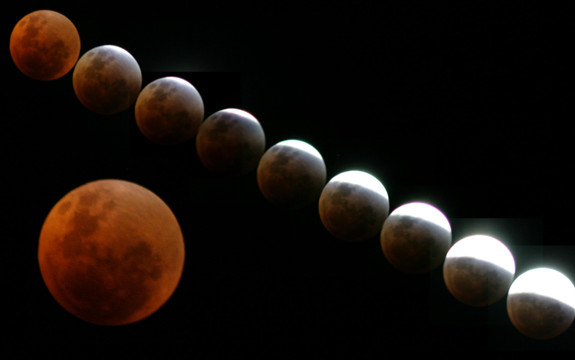Last chance to see Lunar Eclipse in Australia until 2018

In Summary
Saturday 4 April will be the last total lunar eclipse that Australia will witness for three years. The Eastern States will see the entire event but WA may have a more visually impressive sight as the Moon rises over the horizon blood red.
The entire visible effect of the eclipse will last for 3 hours 30 minutes, with a brief totality occurring from 10.57 – 11.02pm AEDT. The timing of the event across the region is listed below in local times:
NSW / Vic / Tas / ACT:
starts at 9.15pm; total eclipse 10.57 - 11.02pm; entire eclipse ends at 12.45am (5th April)
QLD:
starts at 8.15pm; total eclipse 9.57 - 10.02pm; entire eclipse ends at 11.45pm
SA:
starts at 8.45pm; total eclipse 10.27 - 10.32pm; entire eclipse ends at 12.15am (5th April)
NT:
starts at 7.45pm; total eclipse 9.27 – 9.32pm; entire eclipse ends at 11.15pm
WA:
starts at 6.15pm, total eclipse 7.57 – 8.02pm; entire eclipse ends at 9.45pm
Japan (Tokyo):
starts at 7.15pm (JST), total eclipse 8.57 – 9.02pm; entire eclipse ends at 9.45pm
China (Beijing)*:
starts at 6.33pm (CST); total eclipse 7.57 – 8.02pm; entire eclipse ends at 10.45pm
SE Asia (Jakarta)*:
starts at 5.52pm (WIB), total eclipse 6.57 – 7.02pm, entire eclipse ends at 8.45pm
* Regions so far west that eclipse has already started before moonrise, instead the time of moonrise is given.
Swinburne University of Technology astronomer Dr Alan Duffy said that this will be the last total lunar eclipse visible from Australia until 2018 so make sure to head outside and, weather permitting, look out for some key aspects of the event.
“The eclipse begins with a shadow slowly appearing on the surface of the Moon. This is the Moon passing from the outer edge of our Earth’s shadow, called the penumbra, into the darkest region, the umbra. Over the next hour and a half, more of the Moon will be covered until eventually it lies directly behind the Earth away from the Sun.
“At this point the Moon should be blacked-out as the Sun’s light is entirely blocked by the Earth but it will actually appear blood red. This colour is from all the sunsets of Earth shining onto the Moon. Our atmosphere bends or scatters the light onto the Moon even though it’s directly behind us. If we had no atmosphere the Moon would be completely invisible at this point.
“In this eclipse totality lasts for only five minutes, making it the shortest eclipse of the century. The Moon then leaves the umbra and the series of events reverses over the course of the final hour and a half.
“Unlike a Solar Eclipse when the Moon passes between the Sun and the Earth, the Lunar Eclipse is completely safe to view and no special precautions are needed.
“As this is such a short eclipse, just skimming the edge of the Earth’s shadow, you may be able to see a range of reddish tones across the face of it, from blood red to a soft pink,” Dr Duffy said.
“If you have any friends who believe in a flat-Earth make sure to point out the shape of the shadow as it passes over the Moon. It will always be curved because the Earth is round, a fact that Aristotle used to prove that the Earth was not flat.”
Check the eclipse prediction by NASA here.

